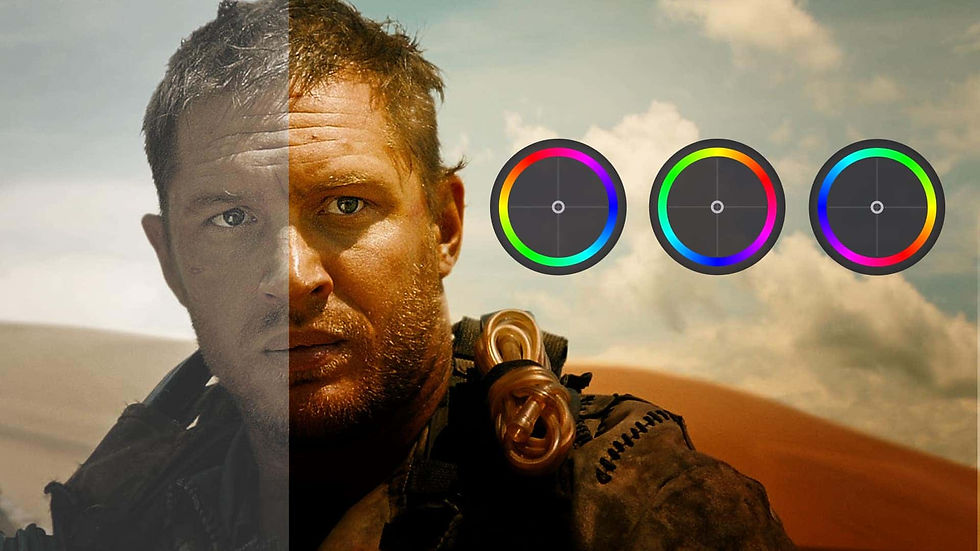Color grade and VFX: an important alliance
- Alex Iwanoff
- Aug 6, 2024
- 4 min read
Updated: Nov 4
In the world of filmmaking, the synergy between visual effects (VFX) and color grading isn’t often talked about, yet it’s crucial. It's the final glaze that perfects the effects. This article explores the essential steps to ensure smooth collaboration between CGI and color grading. After all, even the most meticulously crafted visual effects can falter with missteps in grading.

VFX BEFORE GRADING
In post-production, a workflow principle is that VFX should be done before color grading. This approach preserves the wide dynamic range of the original camera footage. In other words, working with ungraded, raw footage allows the VFX artists to maintain consistency. This means that the VFX team has greater flexibility and control, facilitating the achievement of the desired visual aesthetics. This way also provides colorists with a "raw" canvas to work with, even with the effects already integrated in the plates.
“From the initial acquisition to the final composite, preserving the integrity of the original footage is paramount. When seamlessly blending live-action footage with CG elements, it is essential to work with the highest quality and widest dynamic range possible”, Richard Betts, Head of VFX at Blockhead.
However, not all projects follow this sequential workflow; some may require to work in parallel. For example, in Furiosa: A Mad Max Saga, due to its heavy use of CGI, collaboration between VFX artists and colorists started early on and was crucial for achieving the hyper-stylized aesthetic George Miller envisioned. Eric Whipp, Head of Color, explains in an interview with PostPerspective that this project necessitated a workflow that allowed to iterate quickly, almost in "real time".
“As a lot of the backgrounds in this film are full-CG, we would start with a basic lighting pass and comp of a shot from VFX, then jump into the color suite and play with the look. Often we would try different skies and looks and sculpt the lighting to get it right for the scene”, he states. Once the look was green lit by the director, Whipp would send the reference back to the VFX team, who matched the effects accordingly, without undergoing numerous time-consuming iterations.
“It makes it easier for VFX to move forward, as there’s a reference of where we need to end up”, Whipp adds.
COLOR MANAGEMENT
A common understanding of workflow and color management is crucial from the outset. The industry-standard Academy Color Encoding System (ACES) plays an important role by standardizing color processes across different digital formats. This ensures consistent and reliable color reproduction throughout the production process. Adherence to ACES allows VFX studios to return their completed work in the same format and color as initially received, thereby preserving the integrity of the original footage.
LUTs AND COLOR BIBLES
Creating an early LUT for key or "hero" shots is an effective (and important) way to provide a reference point for VFX studios. This LUT acts as a preliminary color guide, allowing VFX artists to align their work with the intended visual style of the film. Similarly, comprehensive color bibles are sometimes developed; for instance, Greg Fraiser, the Director of Photography for Villeneuve's Dune, crafted color bibles that significantly influenced the visual effects' color pipeline.
As described by the American Society of Cinematographers (ASC), Fraiser and the assistant editor initially edited the film in scene orde to establish a visual baseline.
“I took wide shots and close-ups of important scenes, put those into a timeline, and graded them to capture Denis’ vision, and my vision. [It was] just a series of images that represented our intent. During the post process, as [visual-effects supervisor] Paul Lambert and his team added backgrounds, the color bible was a reference, so they could apply that LUT to make sure it was going the way we wanted”, Greg Fraiser, Dune DOP.
THE RISK OF COLOR GRADING ON VFX
While color grading can enhance a film's visual appeal, it also has the potential to disrupt the harmony of CGI elements. Small discrepancies like misaligned hues or subtle changes in shadows can cause digital effects to stand out unnaturally, breaking the illusion of realism. Conversely, a skillful color grade can uplift and even salvage a visual effect. Minor adjustments like tweaking the intensity of smoke, atmospheric rays, or making slight hue shifts can all be managed directly in the color grading suite.

Sometimes, the VFX studios may also propose, within the parameters of the LUT or movie bible given, a grading. One that works ideally with the effect on the shot. This is sent either as a still or as metadata. Never baked into the footage.
“It happens sometimes that we need to propose a creative grade on that sequence, because it will better serve the work of the VFX artist. Obviously, we would never ever step against the created or defined look that was done between the DOP and the colorist”, confesses Christian Ganea Reitmeier, VFX colorist for DNEG, in a MixingLight podcast.
IT'S ALL ABOUT ENHANCING. NOT CONTRADICTING.
In conclusion, the dance between VFX and color grading is an art that defines modern filmmaking. By strategically defining where the VFX sit in the pipeline, embracing early collaborations and sticking to standards like ACES, filmmakers can end up with visually stunning shots. Done right, this alliance doesn't just enhance a film; it transforms it.
It makes it captivating.











Comments